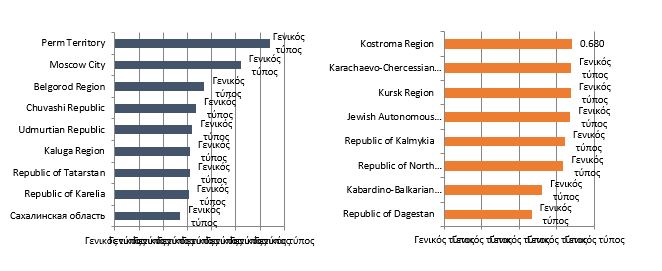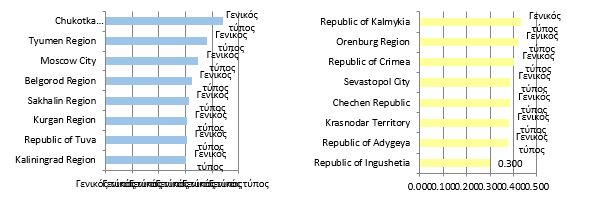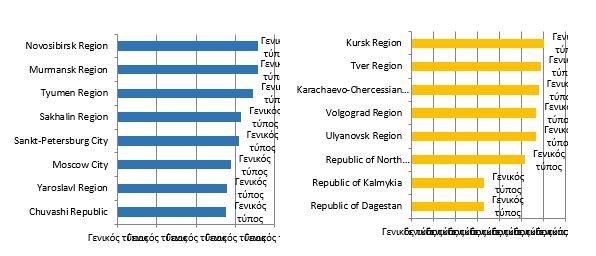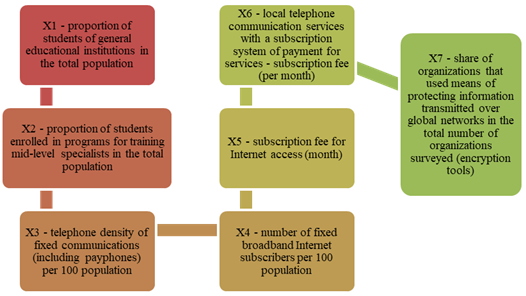Abstract
In the era of the economy digitalization, the role of integrating information technologies into the social sphere is increasing, which directly affects the development of human capital. Intelligent and information and communication technologies (ICT) are important components of human development. The introduction of ICT into the social sphere creates new opportunities for its transformation and development. The transition of Russia to the digital economy, approved by the Digital Economy in the Russian Federation (RF) program, implies the transformation and reorganization of the social sphere. In this regard, the problem of digital transformation of the social sphere is relevant at the present stage of the digital development of society. The authors conducted a study of interregional differences in the implementation of ICT in the field of health care, education and culture. The place of each specific region in the rating of regions in the Russian Federation is determined by measuring differentiation of constituent entities according to aggregate estimates of each block of the electronic social sphere. These estimates consider the impact of all the main indicators selected for analysis and characterize the level of digitalization of the social sphere of each constituent entity. The factors influencing the interregional differences in the level of digitalization of healthcare, education and culture were identified, their quantitative assessment was given, and the clustering of the RF regions was performed according to these factors. The results of the study revealed a digital inequality in terms of the studied aggregate indicators of the social sphere.
Keywords: Digitalizationregionsocial spherestatisticstransformation
Introduction
Currently, there is a global transformation of the industrial society into the informational one, through the development and dissemination of new ICT in all spheres of economic and social life. The widespread use of ICT currently contributes to the active development and improvement of information and analytical systems to ensure state policy in the social sphere. During modernization of the social sphere, ICTs act as a foundation, since thanks to them, it is possible to get the improved processing of information, which occupies an essential place in the life process of society. The system for monitoring indicators of the development of the social sphere plays a significant role in the development and implementation of projects on developing the information society. The monitoring system performs the function of feedback, while allowing you to obtain the necessary information about imbalances in the development and formation of the information society, as well as monitor the implementation of programs.
Monitoring is carried out both by indicators that show the readiness to use ICT for the development of certain spheres, such as education, health, culture, etc., and by indicators that show the use of ICT. The study of the development of electronic medicine includes the following indicators: the use of the Internet for collecting and processing medical information, dissemination of consulting and diagnostic services via electronic communication channels, the availability of online medical information and the ICT competence of medical personnel.
To determine the possibilities of the Internet in the development of the Russian educational system, monitoring includes research in the field of e-education, which makes it possible to analyze the use of ICT in educational institutions and the development of distance education. To assess the level of ICT dissemination in cultural institutions, monitoring includes a study of the information base of cultural organizations, digitalization and availability of cultural funds in the global network.
Problem Statement
Research by Russian and foreign scientists over the past few years has been devoted to the issues under consideration. The prerequisites and conditions for the massive use of digital technologies, and the consequences and results of digitalization of the main sectors of the social sphere are considered. Due to the development of the digital environment, the cultural level of the population and new professions are growing; there is a polarization of knowledge in society, new competencies appear. At the same time, some professions may disappear (Romanova, 2020). To assess the impact of digitalization on the quality of life of households, based on sample surveys, the Russian Regional Index of the Digital Component of the Quality of Life of the Population (RRICKZHN) was developed (Litvintseva et al., 2019). The study of the sphere of transformation of digital technologies into management, the economy and the social sphere suggests that digitalization processes are quite successful in the Russian Federation (Achba et al., 2019). Other scientists also note positive results of of state programs for the digital economy development in Russia. According to the authors, there are objective prerequisites for the development of e-health with the help of the Unified State Health Information System and electronic document management (Myzrova & Tuganova, 2018).
Digitalization, new e-health applications and data-driven algorithms can significantly contribute to the development of the healthcare system. But new technologies also come with new risks. In addition, technical measures should always be built into the overall concept of organizational measures, adequate education, training and related research to ensure the highest possible benefits and the lowest possible risks (Müller, 2020). The specificity of modern digital education is determined by the mass character of communication and globalization of information processing. Information technology affects all spheres of life, including the process of learning, acquiring skills, acquiring experience and competencies (Novikova & Novikov, 2020). Digitalization of the educational process requires specialists with fundamentally new competencies, which will lead to reorganization of the higher education system, the negative consequences of which are insufficient funding for teaching staff of information technology and a tendency to reduce the cost of digitalization in education. In the future, this will lead to underdeveloped education in the field of teaching new technologies and training specialists with competencies that are not in demand on the market (Plotnikova, 2019). Digitization and the use of ICT open great opportunities for cultural institutions responsible for the preservation of cultural and historical heritage sites. Tools are needed to observe, search, organize, generalize and analyze both traditional and electronic sources of information. Important problems in the field: lack of national strategies and policies, lack of standardization and uniformity in the technical implementation of digitization, lack of a single national portal for promoting digital content, etc. (Tsvetkova et al., 2020).
Statistical tools using mathematical methods for regional studies imply the widespread use of new digital technologies. As an improvement in the methodology for analyzing the region’s cluster development, it is suggested to use the difference in differences (DiD) method, which makes it possible to assess the clustering effect as the difference between the results before and after the formation of the cluster. This will allow cluster interactions to be managed using a virtual business environment as an organizational platform with a multidimensional network architecture (Charykova & Markova, 2019). The analysis of scientific works showed that, despite the relevance of the topic under study, the problem of transforming the social sphere due to the digital economy development has not been sufficiently studied. Consequently, we see a lack of research on the statistical aspect of the digital inequality in the social sphere at the regional level.
Research Questions
The main questions of this study are the following:
-determine the main directions of digitalization of the social sphere;
-analyze sources of statistical information at the regional level;
-form a system of statistical indicators to calculate aggregate estimates for blocks of the electronic social sphere;
-carry out the interregional comparative analysis of digitalization of the social sphere using the PATTERN method;
-identify and quantitatively assess factors affecting the difference in the level of digitalization of the social sphere in constituent entities of the Russian Federation;
-cluster regions of the Russian Federation by determinants of the level of digitalization of the social sphere.
Purpose of the Study
The purpose of this study is to statistically study the digital transformation of the social sphere of constituent entities of the Russian Federation. The object of study is the regional level of digitalization of the social sphere. The subject of the research is quantitative assessments and patterns of the social sphere development due to the digital transformation of the economy.
The regulatory framework includes state and federal programs aimed at developing the social sphere in the context of digitalization, passports of Education, Healthcare and Culture national projects, strategies for economic and scientific and technological development. The information base of the study is based on the results of monitoring carried out by Rosstat for calculating and assessing the development index of the information society of RF constituent entities. The authors used the data of the information system Electronic Region. They allow you to form a passport for digitalization of the country's regions, as well as make ratings of constituent entities by the level of development, collect and analyze information on the development of digitalization in the regional aspect.
Research Methods
As a statistical toolkit, the authors also used: the method of aggregate indicators, multidimensional statistical methods of analysis: correlation-regression and cluster, tabular and graphical methods of data presentation, and others. For a comparative assessment of indicators of digitalization of the social sphere - education, healthcare and culture - the PATTERN method was applied. The application of this method is to find the average values from the normalized values of private indicators, which are based on comparing their private and best values. An aggregate estimate is also calculated from normalized values of particular indicators. The levels of digitalization were calculated for each block of the electronic social sphere.
The indicators for calculating aggregate estimates for the blocks of e-education, e-health and e-culture include indicators of the use of ICT for the development from the corresponding sections of Monitoring the Development of the Information Society in the Russian Federation for 2018 (Federal State Statistic Service, 2020). When conducting the correlation and regression analysis, the composition of factors for modeling interregional differences in levels of digitalization of the social sphere was taken from the section Factors of the Information Society Development of the above monitoring.
Findings
The authors revealed a digital inequality in terms of the studied aggregate indicators of the social sphere. Leading regions and outsider regions (by 10% groups) are presented in Figures

In terms of digitalization of education, the Chukotka Autonomous Region ranks first in the rating according to aggregate estimates, and the last is the Republic of Ingushetia (Figure

The best conditions for the development of digital cultural values are observed in the Tomsk region - 71.7% of the best values of private indicators, and the lowest level - in the Republic of Dagestan - 16.4% (Figure

The multiple correlation and regression analysis for 82 constituent entities of the Russian Federation (dependent variables (Y) are aggregate estimates for the sectors of the social sphere, independent variables are factors of the development of the information society from the above-mentioned Monitoring) revealed factors that have a direct impact on the development of the electronic social sphere in the Russian Federation (Figure

The variation in the interregional level of development of the digital social sphere depends to the greatest extent on fixed broadband Internet subscribers per 100 population (X4), monthly subscription fees for Internet access (X6) and the share of organizations that used means of protecting information transmitted over global networks (X7).
To classify constituent entities of the Russian Federation by the level of digitalization of the social sphere, we use factor signs included in regression models for blocks of the electronic social sphere. The effectiveness of the classification into 4 clusters was assessed using the variance analysis. The intergroup variance in almost all indicators is greater than the intragroup variance, which allows us to conclude about the effectiveness of this clustering. This conclusion is also confirmed by the values of the F-criterion and the level of significance - p ≤ 0.05.
The cluster analysis shows that constituent entities of the Russian Federation have formed 4 distinct clusters according to factors that determine the level of development of informatization of the social sphere.
The largest number of constituent entities is included in the cluster with an average level (43.9%) of informatization of the social sphere and with a low level (30.4%). A high level of development of the electronic social sphere can be noted in 14.6% of regions. The level of digitalization is below average - in 11% of all RF constituent entities. The resulting typology of regions accurately reflects interregional differences in digitalization of the social sphere in the Russian Federation.
Conclusion
Digitalization of the social sphere is an integral part of the development of the digital society in the Russian Federation. This process has great development prospects and implementation difficulties. Currently, there is a digital divide in certain blocks of the social sphere. Differentiation of the level of digitalization of culture is 2.5 times, education - 1.8 times, healthcare - 1.4 times. The results of the study confirm that at present there is a digital transformation of the social sphere through the development and dissemination of new ICT in all spheres of economic and social life. There is also a significant differentiation of constituent entities by the level of development of digitalization of the social sphere in the Russian Federation. A low level of digital development of the social sphere in almost a third of all regions. Despite this, almost all constituent entities of the Russian Federation have all the prerequisites for the development of the electronic social sphere and its digital transformation, which will increase the quality of life of the population. Significant regional differentiation of the level of informatization of society and the social sphere determines the need for state regulation based on the identified stable statistical regularities of informatization of society, both common for Russia and some regions and territorial constituent entities.
References
- Achba, L. V., Vorona-Slivinskaya, L. G., & Voskresenskaya, E. V. (2019). Digital transformation of management, economy, and social sphere: Reality and prospects. Economics and Management, 6, 26-31. DOI:
- Charykova, O. G., & Markova, E. S. (2019). Regional clustering in the digital economy. Economy of Region, 15(2), 409-419. DOI:
- Federal State Statistic Service (2020). Information society. https://gks.ru/folder/14478
- Litvintseva, G. P., Shmakov, A. V., Stukalenko, E. A., & Petrov, S. P. (2019). Digital component of people’s quality of life assessment in the regions of the Russian Federation. Terra Economicus, 17(3), 107–127. DOI:
- Müller, T. (2020). Information technology and eHealth to improve patient safety. INTERNIST, 61(5), 460-469. DOI:
- Myzrova, K. A., & Tuganova, E. A. (2018). Digitalization of health care as a perspective direction of development of the Russian Federation. Innovation Economy Issues, 8(3), 479-486.
- Novikova, M., & Novikov, F. (2020). Informatization of education in the modern paradigm of teaching Russian as a foreign language to international law students. In L. G. Chova, A. L. Martinez, & I. C. Torres (Eds.), Proceedings of the 14th International Technology, Education and Development Conference (INTED) (pp. 5590-5595). Iated-Int Assoc Technology Education & Development.
- Plotnikova, E. (2019). Digitalization of education in the leading universities of Saint Petersburg. IOP Conference Series-Materials Science and Engineering, 497, 012047.
- Romanova, N. V. (2020). Digitalization of services in the social sphere: Problems and prospects. Вulletin USPTU. Science, Education, Economy. Series Economy, 1(31), 58-65. DOI:
- Tsvetkova, E., Savova, E., & Vasileva, H. (2020). Digitalisation of cultural and historical heritage: Challenges and prospects. In L. G. Chova, A. L. Martinez, & I. C. Torres (Eds.), Proceedings of the14th International Technology, Education and Development Conference (INTED 2020) (pp. 5478-5482). Iated-Int Assoc Technology Education & Development.
Copyright information

This work is licensed under a Creative Commons Attribution-NonCommercial-NoDerivatives 4.0 International License.
About this article
Publication Date
30 April 2021
Article Doi
eBook ISBN
978-1-80296-105-8
Publisher
European Publisher
Volume
106
Print ISBN (optional)
-
Edition Number
1st Edition
Pages
1-1875
Subjects
Socio-economic development, digital economy, management, public administration
Cite this article as:
Proskurina, N. V., & Forrester, S. V. (2021). Statistical Study Of Inter-Regional Differentiation Of Digitalization In The Social Sphere. In S. I. Ashmarina, V. V. Mantulenko, M. I. Inozemtsev, & E. L. Sidorenko (Eds.), Global Challenges and Prospects of The Modern Economic Development, vol 106. European Proceedings of Social and Behavioural Sciences (pp. 1111-1118). European Publisher. https://doi.org/10.15405/epsbs.2021.04.02.132

